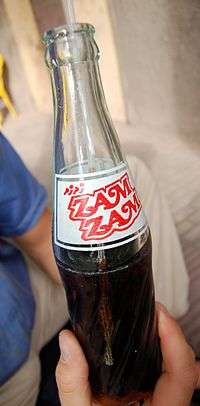Zamzam (soft drink)
|
A bottle of the cola variant of Zamzam | |
| Type | Soft drink |
|---|---|
| Manufacturer | Zamzam Group |
| Country of origin | Iran |
| Introduced | 1954 |
| Variants | Cola, lemon, orange, lemonade, mango, mineral water |
| Related products | Mecca-Cola, Qibla Cola, Eram Cola, Parsi Cola, Cola Turka, Coca-Cola |
Zamzam (Persian: زمزم formerly Zamzam Cola) is a brand of soft drink produced in Iran by Zamzam Group. It is particularly popular in parts of the Muslim world, having gained a status there as a Muslim alternative to American products such as Coca-Cola and Pepsi. Zamzam is also one of the few remaining soda companies in Iran that uses refillable glass bottles.
The director of the Zamzam Group is Ahmad-Haddad Moghaddam. Zamzam Group is owned by the Mostazafan Foundation.
History
Originally a subsidiary of Pepsi created in Iran in 1954 as the first Iranian carbonated soft drink producer, Zamzam became its own corporation following the 1979 Islamic Revolution.
Following the 2002 boycott of Coca-Cola by Saudi Arabia, Zamzam was unofficially dubbed the soft drink of the Hajj.[1]
The product's name is a reference to the Well of Zamzam in Mecca, that is one of the stops on the Islamic pilgrimage of the Hajj.
The headquarters of Zamzam are in Tehran, Iran. The bottling facility in Tehran is a popular attraction where people can see the drink being bottled. Due to the bottling facility's proximity to Mehrebad airport tourists often stop to look.
The production was at first a single production line, and now it owns seventeen beverage plants in Iran as well as several international companies, which produce and distribute Zamzam products under its licence. Zamzam Group has developed the most well equipped beverage concentrate plant in the Middle East. Zamzam Group had significant presence in domestic and international markets, and produces over one hundred diverse products including Cola, lemon, orange, lemonade, mango, mineral water and non-alcoholic malt beverage. Zamzam is also available in the United Arab Emirates and other surrounding nations.
References
- ↑ Islam Online- News Section Archived May 15, 2006, at the Wayback Machine.
External links
- Official website
- Zam Zam Foods North America Inc, distributors in the United States and Canada.
- "Cola wars as Islam shuns the real thing", article from The Times, October 11, 2002.(registration required)
- Islamic cola 'selling well in Saudi' BBC News - August 21, 2002
